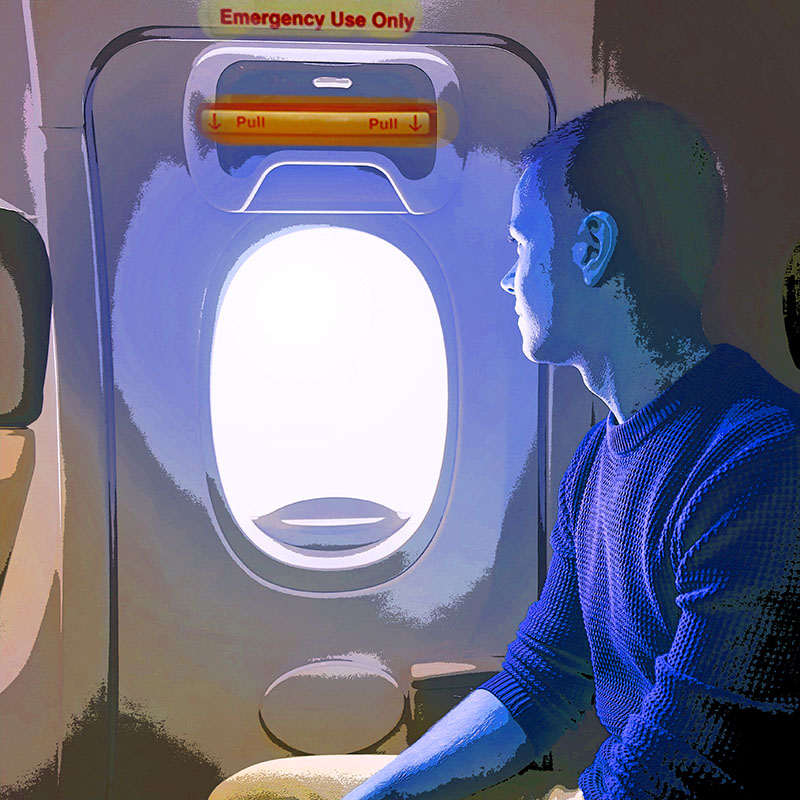What Pre-Flight Safety Speeches Teach Us About Safer Sex
By Mia Barrett, MEd | March 8, 2018
I spend a lot of time traveling for my work as a research coordinator. I’m in airports and on airplanes all the time. I board my plane, find my seat and listen to the flight attendant deliver the pre-flight safety speech.
Every time I fly, I hear that speech: lift up on the tab, insert the buckle, keep in mind that the exits may be behind you. Every time. It doesn’t matter if this is my first time flying or I’m a gold-platinum-extreme member, the flight attendants provide safety details and protocols for the flight. They explain the risks, remind me of the destination and go over some of the perks.
As a sexuality educator, I’d like to see us teach that sexual interactions should come with a similar safety briefing. Both experiences can be risky. They can produce turbulence. They can be fun. And…wait for it…they can take you places you’ve never been before.
Having the “safer sex” talk with someone new can be nerve wracking. Some argue that it takes the spontaneity out of it all. But if I got on an airplane and the flight attendant said, “We’re skipping the safety briefing today in favor of spontaneity,” I would find that emergency exit immediately!
And notice that the safety briefing occurs while the plane is on the ground, well before we hit any rough air or need to know where the life vests are. These are the same reasons it’s a good idea to have the talk with a sexual partner before things start taking off.
Exit Rows
Last time I flew, I was seated a few rows behind the emergency exit seats. A flight attendant approached the row and asked if the passengers there were willing and able to assist in case of emergency. The man in the aisle seat nodded his head up and down.

The flight attendant explained that the man needed to respond verbally. So much can be misinterpreted with non-verbal communication. Given what is at stake, the risk of miscommunication is too great. A verbal yes or no is the clearest way to provide consent when you’re seated in an exit row.
Similarly, when someone is communicating their needs and desires with a sexual partner, relying on body language alone can lead to miscommunication. This is why it’s so important to use words to give and receive consent.
I hope that those passengers in the exit row are truly willing and able to assist, and not maybe sort of willing and able. I hope that if a person in the exit row thought to themselves, “Well, maybe I am able,” they would move to another seat.
In a sexual encounter, if someone is unsure about whether they can say yes to something, I want them to know that they have the option to say no. I hope they’ll find an alternative activity that is more suitable to their own wishes and desires.
Know the Safety Features
Flight attendants tell you about the safety features of the plane. The plane has lights along the aisle, inflatable slides, flotation cushions and oxygen masks. The pilot gives you more information about how the plane is equipped.
This is more excellent modeling for sexual relationships. People can discuss their own safety features with their partner(s), including STI and pregnancy prevention methods. Personal safety features might include an IUD, condoms, dental dams or lube. People might also choose to limit their use of drugs and alcohol.

Each plane is inspected before each flight. Maintenance crews check the bolts, the tires, cables for the landing gear, the windshield and so on for anything amiss. In-depth inspections are scheduled regularly. You wouldn’t want to fly in a plane that wasn’t properly maintained!
Similarly, sexually active individuals can do regular self-checks—any sores, blisters or unusual discharge around the mouth or genitals? People with penises can do testicular self exams. Everyone can go for regular, in-depth check-ups with a medical care provider. They might receive Pap tests, pelvic exams, breast or testicular exams and STI screening.
If an aircraft maintenance team discovers any problems with a plane, they must inform the pilot of the issues. Similarly, sexually active individuals should let their partners know about any physical symptoms they have, any sexual screening tests they’ve taken, and any risks they’ve engaged in since their screening tests.
Cross Check and All Call
Flight attendants check each others’ work, making sure they’ve fulfilled each task completely. Then they have a crew-wide conference call. This is called “cross check and all call” for short, and the plane won’t take off without this step.
Sexually active people can have their own cross check and all call. They can check in with partners about each others’ needs and desires. They can create a space for those conversations to make sure needs are being identified and addressed before take off.
Compliance with Instructions
FAA regulations require that passengers comply with crew instructions. Whether it’s the ban on tampering with smoke detectors or not allowing you to bring your comfort peacock aboard, what the crew says goes. With sex, each participant must respect the personal regulations of their partner(s). It’s vital to comply with stated personal boundaries.
Know That Oxygen Is Flowing
Those oxygen mask guidelines suggest other rules that will work in sexual relationships. Help yourself before helping others. Take care of your needs before taking care of others. Even when things get rough, know that oxygen is flowing and you can breathe.

Time for Take Off
Am I right? Are there not some amazing similarities between safe flight and safe sex? (You may never think about a pre-flight safety speech the same way again.)
Let’s share the wisdom! This is a fun and entirely practical way to provide safer sex education. It covers all the necessary bases. Ah—but that’s another metaphor and a post for another day.
Let me know if the safety speech idea works for you. I’d love to hear what you think about it.
Mia Barrett is a Research Associate at ETR as well as a sexuality educator for young adults and health care professionals. She received her Master’s in Education in Human Sexuality at Widener University.




